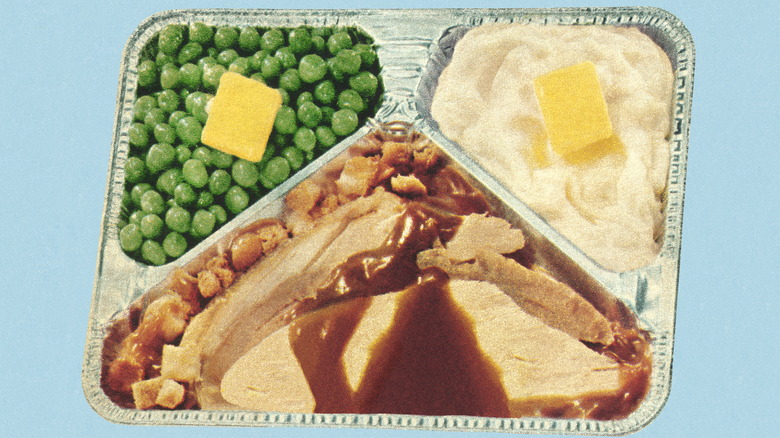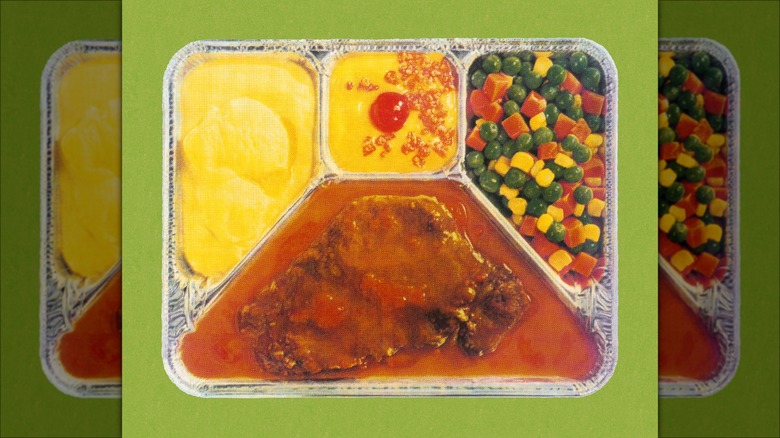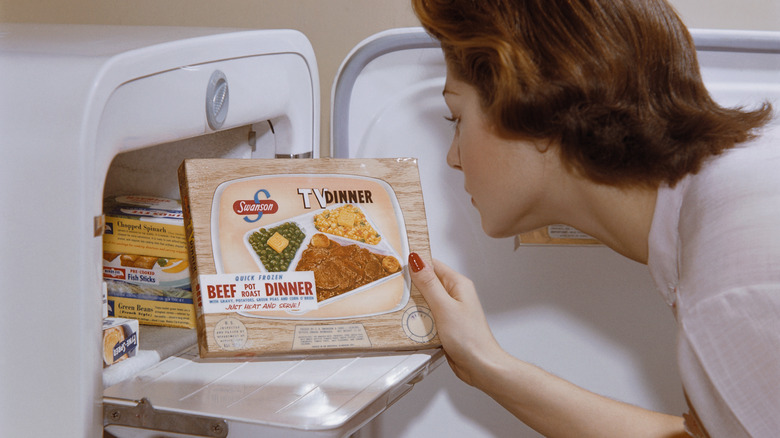Strato-Plates: The Retro Futuristic Origin Of Frozen Meals
Pre-packaged frozen meals are super convenient to have on hand. When you need a meal in a pinch, you can grab one from your freezer and heat it up in no time. And when you do so, you are actually reaching for something that started out as a high-tech project for airplane meals for both soldiers and civilians called Strato-Plates.
Though the earliest version of frozen food was packaged poultry shipped from Russia to London in the 1800s, commercial frozen products actually didn't hit grocery stores until 1930 with items like fish, meat, spinach, and raspberries packaged by the company Birdseye. Strato-Plates, created by William Maxson of Maxson Food Systems, Inc. took it a step further in 1945 with that multi-compartment meal that would come to be known as the TV dinner, offering partitioned sections for meat, potatoes, and vegetables. The meals were packaged on a resin-coated paper tray, and used flash freezing technology.
Before eating the TV dinners with the family in front of a television set, however, these Strato-Plate meals were intended for in-flight noshing. Maxson Food Systems even invented a small, lightweight, oven — to account for the weight constraints on an airplane — that could cook six frozen meals twice as quickly as a conventional oven. Previously, the only meals available on flights were cold sandwiches and military rations.
What happened to the Strato-Plate?
It seemed like William Maxson's frozen meal invention was poised for the big time. Post-airplane takeover, he intended to introduce Strato-Plates to the retail market and even had plans to expand into individual items like frozen fries, corn, carrots, and turkey, all of which aimed to help get dinner on the table more quickly. However, Maxson's untimely death in 1947 as well as an already tenuous financial situation of the company meant that Strato-Plates never actually saw the grocery store freezer aisle.
However, the heating technology that Maxson invented, called the Maxson Whirlwind Oven, provided the groundwork for the modern convection oven and everyone's latest favorite kitchen gadget, the air fryer. The oven and its later variations work by using fans to quickly circulate hot air, and there has been a patent on it since 1949. Even though the trendy new microwave took the spotlight off of Maxson's invention, nevertheless, his design laid the crucial foundation for later inventions.
Who made retail-ready TV dinners?
Other companies piggybacked on the invention of Strato-Plates. Frozen Dinners Inc. sold multi-compartment frozen meals on aluminum trays under the brands One-Eyed Eskimo and Quaker State Food Corporation. The company, run by the Bernstein brothers, had already sold millions of frozen dinners, but it was Swanson's that actually named the dish "TV dinner" and rocketed it into infamy as Swanson's strong advertising campaigns in 1954 cemented TV dinners into American culture.
Swanson's is sometimes credited with inventing the multi-compartment frozen meal because of this very successful marketing campaign as well as some claims from employees that worked at the company at the time. Swanson's did fine-tune the design and packaging, and Betty Cronin who worked for Swanson's completed research to improve techniques so that each food item finished cooking at the same time.
However, the original idea definitely came from the Strato-Plate invented by William Maxson. So the next time you grab a frozen dinner and pop it in the air fryer, you have William Maxson to thank!



